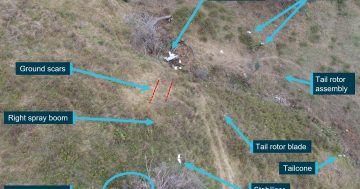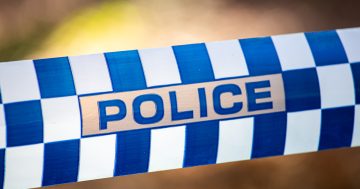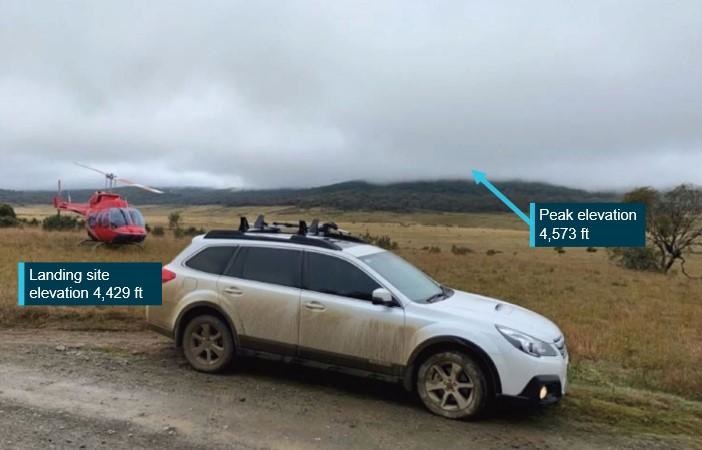
This photograph shows the Bell 206L-4 LongRanger helicopter in the Brindabellas before the pilot decided to take off in poor conditions. It crashed not long after. Photo: ATSB report via NSW Police.
The final report into a fatal helicopter accident at Kiandra Flats has found cloud and poor visibility conditions “highly likely” led to a pilot losing control of his aircraft before an “unsurvivable” crash.
The Australian Transport Safety Bureau (ATSB) has released its final findings from the 3 April crash, which killed a Sydney couple.
The Bell 206L-4 LongRanger helicopter (registered VH-PRW) was one of a tour group of seven aircraft which left a private property near Majura, near Canberra, and were travelling to Mangalore, Victoria, with a planned refuelling stop in Tumut.
They had been operating a visual flight rules (VFR) flight, which is one in which visual meteorological conditions must be good.
The VH-PRW pilot held a private licence and did not hold an instrument rating, and the helicopter was not approved for instrument flight.
On the day, the weather forecast was for low cloud, rain and associated reduced visibility on the planned route. Two of the helicopters diverted to Wagga Wagga while another four landed near Wee Jasper, north-west of Canberra.
“The pilot of the VH-PRW did not land but continued south to ‘attempt to find a way through to Tumut’,” the report stated.
The helicopter landed shortly before midday along Long Plain Road in the Brindabella region, west of Canberra, due to poor weather conditions. It is in an area with no mobile reception coverage.
A passing motorist stopped to make sure they were OK.
“The pilot advised the motorist that they had landed to wait for better weather conditions before continuing the flight,” the report stated.
The motorist returned to the spot about 2:15 pm and drove the pilot to a spot with mobile coverage so he could contact the tour operator to let them know they were OK, but planned on continuing the flight following powerlines about 50 ft above the ground.
“The tour organiser advised against this plan and then notified the other members of the tour and authorities of the landing,” the report stated.
Just before 3 pm the helicopter took off again at low level, in overcast conditions with low cloud and light rain, which was witnessed by police officers who arrived just as it became airborne.
“Photographs, along with police and witness reports, showed that at the time of the departure the cloud and visibility were unsuitable for visual flight,” the report stated.
“Departing into unsuitable cloud and visibility conditions, particularly in the vicinity of mountainous terrain at very low level, carried significant risk of both losing visual reference and of collision with terrain.”
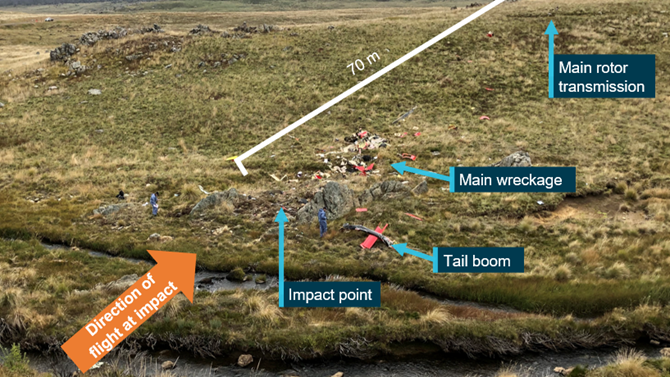
A Bell LongRanger helicopter crashed at Kiandra Flats, killing the two people onboard, on 3 April. Photo: ATSB.
ATSB Chief Commissioner Angus Mitchell said the pilot had originally made the choice decision by landing the helicopter.
“However, you’re only as safe as your last decision, and the pilot’s then decision to launch again and push on – for reasons we will never fully comprehend – put the helicopter into a dangerous environment with powerful and misleading orientation sensations and no visual cues.
“It is highly likely these cloud and visibility conditions resulted in the pilot experiencing a loss of visual reference and probably becoming spatially disorientated. Tragically, this led to a loss of control of the helicopter and an unsurvivable collision with terrain.”
Recorded data showed about 3:25 pm the helicopter rose rapidly and then entered a steep left descending turn until it crashed at Kiandra Flats.
A search began on 4 April with the accident site found that night.
This is the second weather-related investigation report into a fatal incident this month, with Mr Mitchell stressing the importance of planning ahead to avoid deteriorating weather.
“Ensure you have alternative plans … and make timely decisions to turn back or divert,” he said.
“Know your limits. As a visual flight rules pilot the use of ‘personal minimums’ checklist helps control and manage flight risks through identifying risk factors that include marginal weather conditions.
“Please only fly in environments that do not exceed your capabilities and, most importantly, don’t push it, land it.”
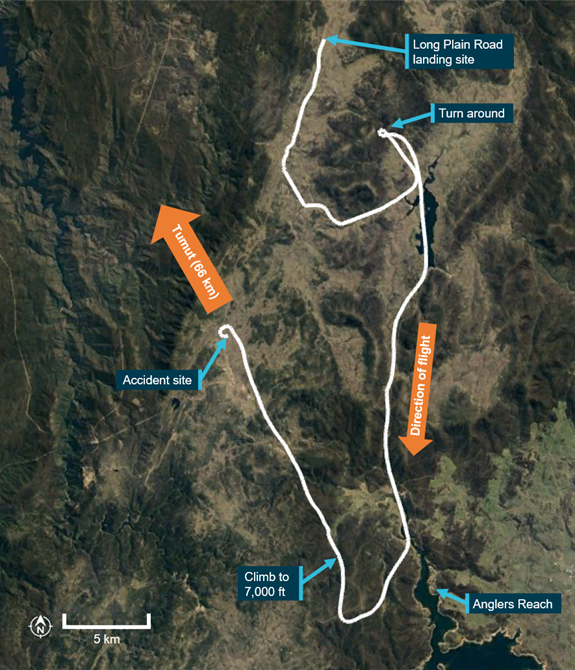
The final flight path by the Bell LongRanger helicopter from Long Plains Road. Photo: ATSB.







